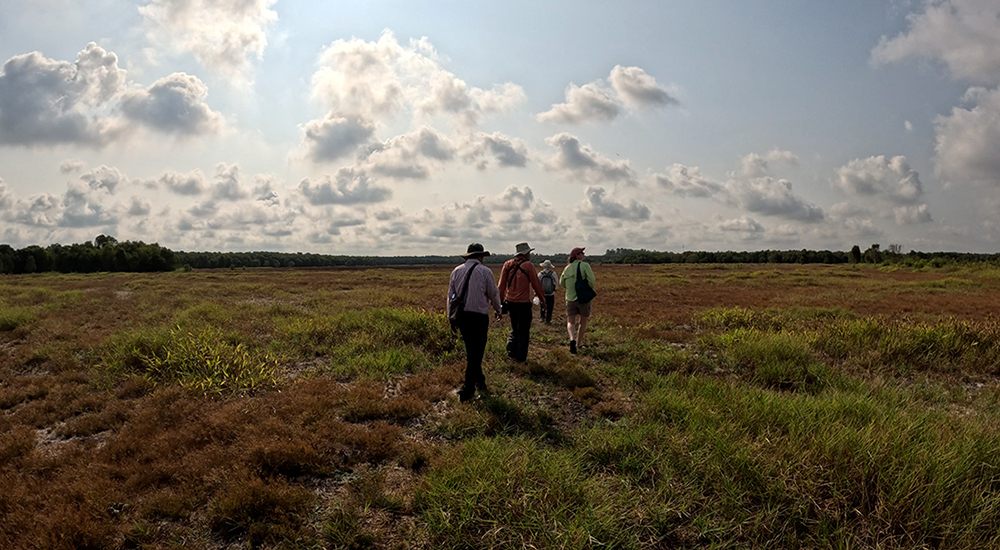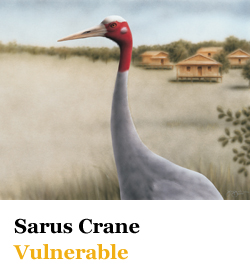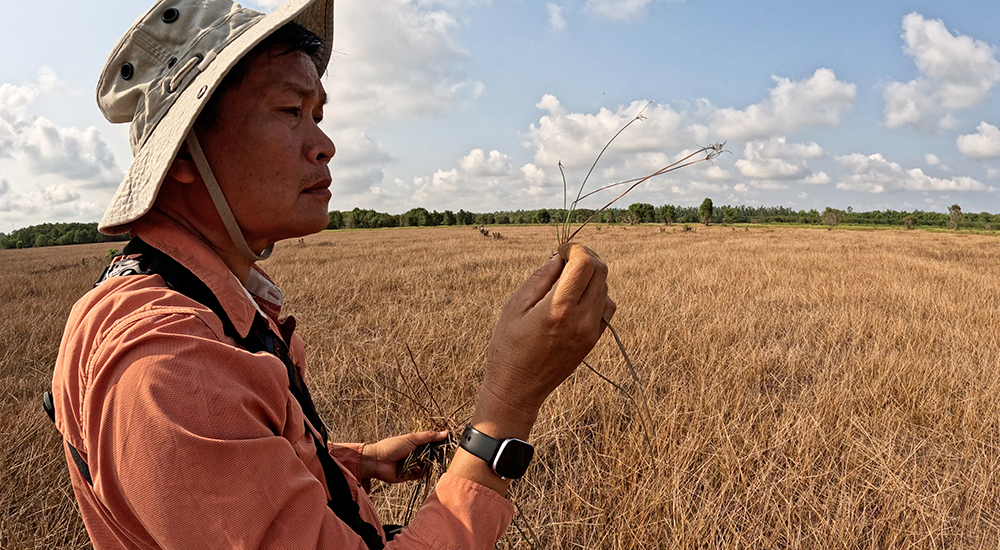

This spring, our Curator of Birds, Kim Boardman, and Director of Conservation Medicine, Dr. Diana Boon, traveled to Vietnam and Thailand to join Dr. Tran Triet, our Southeast Asia Program Director. Their goal was to share our decades of experience and wisdom from the Whooping Crane reintroduction efforts in the United States with a new reintroduction program.
We are partnering with the Government of Vietnam, the Vietnam Zoo Association, and the Zoological Parks Organization of Thailand to reintroduce a nonmigratory Eastern Sarus Crane flock into the bountiful Tram Chim National Park in Vietnam. Rearing and release facilities are under construction, training exchanges are underway between the Thais and Vietnamese, and the first Sarus Crane chicks may arrive later this year.
Following are the field notes from Kim and Diana’s visit:
After traveling 36 hours from Wisconsin to Ho Chi Minh City, Vietnam, we crossed over approximately 100 bridges as we wound our way through the Mekong Delta to the Tram Chim National Park. The plan for the next three days was to visit all five zones that the teams have been working to restore, evaluate the facilities that have been built or modified at the park, and look at the potential Sarus Crane release sites.
Each morning, we started with breakfast at the Wildbird Tram Chim hotel. This hotel was built by dedicated owners who are experts in natural diversity protection, and the husband is completing his Ph.D. with Triet. After breakfast, we loaded onto flatboats, called sampans, for transport to a different park area via the waterways, with birding encounters along the way. The Vietnamese biologists had heard the wild Sarus Cranes calling in the area, but we were not fortunate enough to see them despite a concerted effort. By midday, everyone and everything was shifting into slow mode as the heat became a strong physical presence. We would head out again in the sampan in the late afternoon to visit another area and do more birding. The day ended with fantastic meals at the Wildbird hotel.
Tram Chim was one of the International Crane Foundation’s first global program locations. As we traveled the wetlands, we passed water management structures designed more than 30 years ago by our President and CEO, Dr. Rich Beilfuss, and walked past the bridge where Co-founder, Dr. George Archibald, used to watch Sarus Cranes fly across the fields to roost. It was such a special experience to become part of the Sarus Crane reintroduction story.

We presented information on crane husbandry, shipping considerations for transferring birds from Thailand, and medical considerations at a two-day workshop with Tram Chim National Park staff, Saigon Zoo staff, and Vietnamese government officials. The intensive tour of the park and the captive facilities provided a great basis for the conversations and next steps before the Sarus Cranes arrived from Thailand this summer.
The veterinarian of Saigon Zoo, Mr. Lam Quoc Cuong, was our host for the visit to the zoo in Ho Chi Minh City, where we toured their grounds and talked to documentarians and national news reporters. Mr. Doan Van Nhanh, from the Conservation office of Tram Chim National Park, and Cuong traveled with us to Thailand for meetings and a tour of Korat Zoo and their Sarus Crane reintroduction site in the wetlands of Buri Ram. We participated in another workshop at Korat Zoo to work through additional details related to transporting the cranes from Thailand to Vietnam.
The last part of the trip was a visit to the beautiful Buri Ram reintroduction site. The Zoological Park Organization of Thailand built an environmental education center here in 2002 to honor the cranes, educate visitors about the habitat and program, and serve as a launching site to see the reintroduced Sarus Cranes. During our drive around the wetlands, we saw over 20 of these stately birds among the large numbers of other wetland bird species.
It was a very busy and hot two weeks, but we visited two countries, two major cities, three smaller towns, five provinces, two national parks, three major ecosystems, two main rivers, one Ramsar site, two biosphere reserves, one World Heritage site, and enjoyed a tremendous amount of local food. We also observed the first day of Songkran or Water festival, the first day of the New Year for several Southeast Asian countries.
Everyone we met was an excellent host and immersed us in the local culture. The community’s support for Sarus Cranes was evident throughout our visit as cranes are featured throughout Dong Thap Province where the park is located in Vietnam. We are honored to be part of this international collaboration and look forward to the next steps in introducing Sarus Cranes back into the upper Mekong Delta and Tram Chim National Park.
Story submitted by Dr. Diana Boon, Director of Conservation Medicine, and Kim Boardman, Curator of Birds. Learn more about our work in Southeast Asia here.
